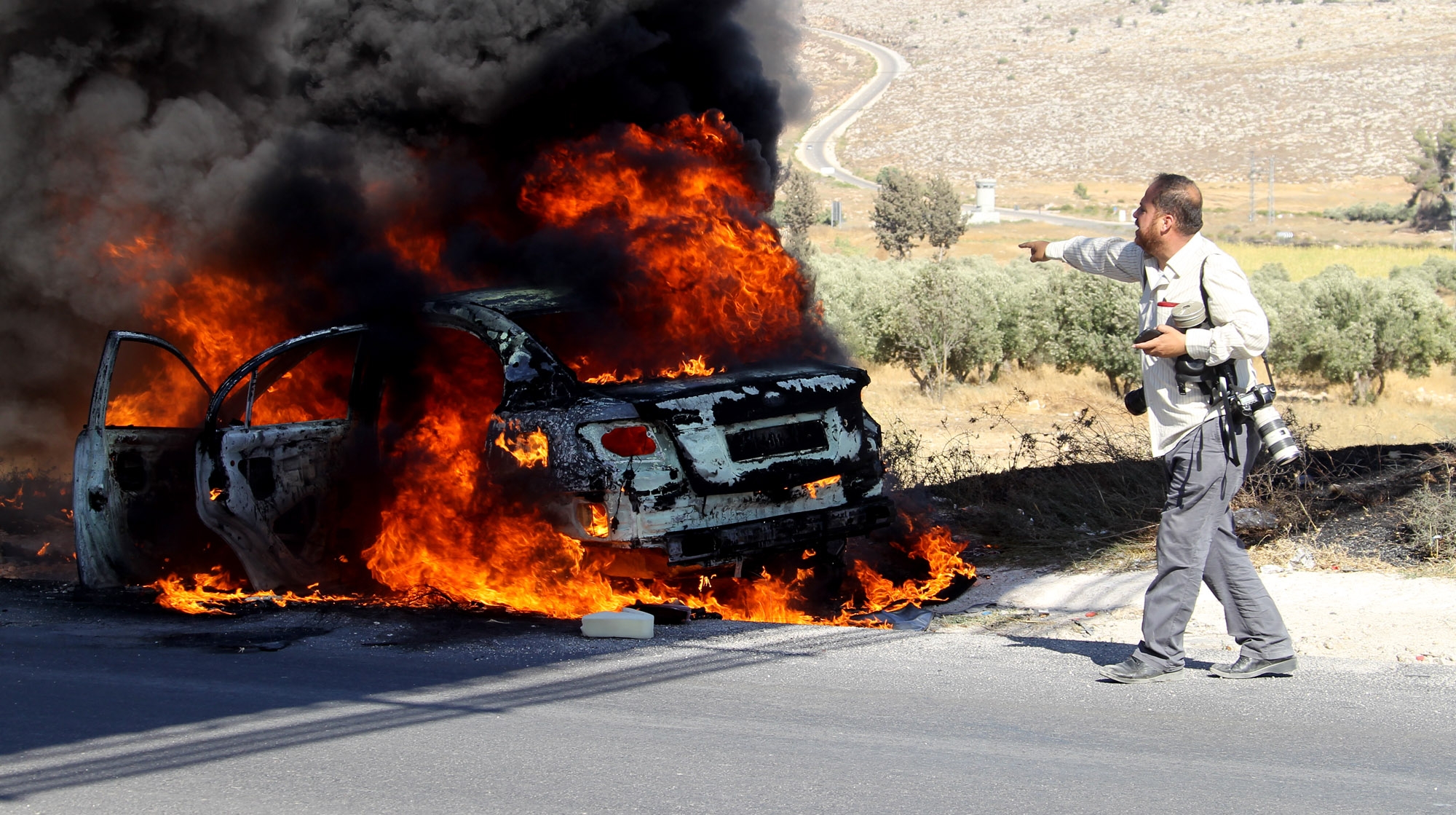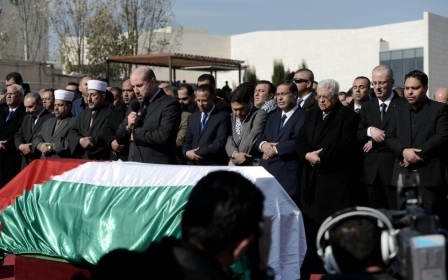Palestinian journalists caught in 'triple jeopardy'

GAZA CITY, Gaza – Since her husband died during Israel’s recent war with Palestinian groups in Gaza, 28-year-old Mariam Mqat and her three children have had to survive on aid from humanitarian organisations and help from family.
“Thank God, we are getting by,” she told Middle East Eye, adding that she, like 41 percent of Palestinians in Gaza, is unemployed. “But it isn’t easy at all.”
While covering an Israeli attack near his home, freelance journalist and frequent contributor to the Istaqlal newspaper Hamada Mqat, 29, was fatally struck by a drone strike in the Tufah area of Gaza City on 4 August. His brother died during a similar attack just a few days earlier.
Hamada, who graduated with a BA in journalism and public relations in 2011, began his journalism career shortly before the eight-day war between Israel and Gaza in November 2012. In addition to providing reports to various online news outlets and publishing updates on Facebook, the journalist taught lessons to students at a local university.
In addition to being the deadliest year for Palestinians in general since the 1967 Middle East war, "2014 was a black year for freedom of the press in Palestine... and it was the worst and bloodiest” yet for media workers in the Palestinian territories, according to the Gaza Centre for Media Freedoms’ annual report.
Sherif Mansour, Middle East and North Africa director for the Committee to Protect Journalists, explained that there is a “triple jeopardy situation for journalists in the West Bank and Gaza."
In addition to Israeli authorities, the ongoing rift between the West Bank-based Fatah party and the Hamas authorities in Gaza has “rendered independent journalism work at risk,” Mansour told Middle East Eye.
“Journalists, like the rest of the civilians, are stuck in between, but they are also under specific threats because the three groups, Israel, Hamas, and Fatah, are enforcing censorship, denying access to critical reports, and are in constant competition over controlling the narrative,” Mansour added.
'Second deadliest place'
At least 16 media workers, including 15 Palestinians and one Italian national, were killed over the course of the seven-week war in Gaza, and dozens more were left injured.
The watchdog group Reporters Without Borders recently released a report that deemed the Israeli-occupied Palestinian territories – the West Bank, including East Jerusalem, and the Gaza Strip – the second deadliest place on earth for media workers behind Syria.
Mariam Mqat recalled the day that her husband died. “We woke up when we heard loud explosions outside,” she said. “The area was very dangerous at the time… it was under attack and Israel was targeting people [in the area].”
“There were some 20 drones flying around above the neighbourhood. Our house was also hit” and was lightly damaged, she explained. “When [Hamada] went outside, he was hit almost immediately. Thank God we weren’t injured in the strike too.”
The three children – two boys and one girl aged between two and five – have struggled to understand that their father is gone. The oldest, Muamman, “didn’t talk for days” after his father died, Mariam explained. “He doesn’t fully understand what happened, but when he sees him on television he gets sad.”
While Israel’s press violations were often fatal, Hamas, the ruling party in Gaza, has also been accused of censorship.
Swairjo Tholfikar, news director of Sawt al-Shaab, a Gaza-based radio station affiliated with the leftwing Popular Front for the Liberation of Palestine (PFLP), has been targeted by both Israel and Hamas authorities.
Most recently, the radio station’s office was destroyed when Israel targeted the Al-Basha Tower in Gaza City on the final day of the war, 26 August. “An Israeli soldier called me at 3 o'clock in the morning and said we have 10 minutes to leave the tower before they bring it down,” he told Middle East Eye. “There was nothing left after they struck it.”
Tholfikar recalled that since its 2006 establishment, Sawt al-Shaab has been targeted time and again. Due to its leftist leanings, it was initially “harassed” by the Fatah-dominated Palestinian Authority in Gaza. “Fatah destroyed our radio equipment back then.”
After Hamas took control in Gaza in 2007, the radio station’s political broadcasts landed it in trouble yet again. “We have been shut down three times,” he noted. “But we have always and will continue to broadcast from the perspective of the opposition.”
Between Israel and the PA
Elsewhere in the Israeli-occupied West Bank, including East Jerusalem, press violations come from both Israeli forces and the Palestinian Authority.
According to a report published by the Ramallah-based Palestinian Centre for Development and Media Freedoms (MADA), more than 30 press violations were committed in the Palestinian territories in December alone.
Palestinian, Israeli and international human rights organisations regularly decry Israel for its treatment of journalists and other press workers, including arrests, censorship and physical violence.
On 5 December, Palestinian cameraman Bashar Nazzal, 36, was “severely injured by the Israeli forces who shot at him with a silencer weapon while he was covering the weekly demonstration against the [Israeli separation] wall in Kafr Qadoum,” MADA reported, referring to a village in the central part of the West Bank.
After Israeli forces confronted the demonstrators with 'skunk water', “the soldiers deliberately shot at me with a single bullet,” Nazzal told MADA. “The bullet hit my leg and exploded there. I was shot at while I was standing far away from the protesters.”
The following day he received surgery in Nablus, another central West Bank city, and doctors removed four bullet fragments from his leg, though he says other shards remain embedded in his leg.
The Palestinian Authority’s press crackdown also intensified throughout December. MADA noted that several journalists and media students were interrogated and arrested over their reportage or Facebook postings.
Among them was Majdouline Hassoune, a 25-year-old correspondent for the As-Safir newspaper and producer at Al-Quds TV. After being summoned to a court in Nablus, she was interrogated for two hours about Facebook posts.
“They accused me of slandering and insulting the president and [important figures in the Palestinian Authority], even though I told them that these posts were fake because my account had been hacked,” she told MADA, adding that the Palestinian preventive security forces are currently pressing charges against her.
'He’s not coming home'
Meanwhile, families of the press workers killed during Israel’s summer war in Gaza have little hope for justice.
An Israeli military press release in December reported that approximately 100 complaints filed against military conduct have been referred by its investigatory body for examination. Nine were announced as already closed and a mere five were recommended for criminal investigation.
Of those complaints made public thus far, only one dealt with accusations that press workers were directly or indirectly targeted by Israeli forces during the military assault: Hamed Shihab, a Media 24 correspondent, was killed in an aerial strike on his car, which was marked as a press vehicle, on 9 July in the Rimal area of Gaza City.
The Israeli military’s investigation concluded that Shihab’s vehicle “was being used to transport weaponry intended to be used against [the Israeli military] or the Israeli civilian population that same day, and [the] passengers were involved in the hostilities,” the press release states.
Yet rights groups, among them the Doha Centre for Media Freedom and MADA, reject these claims, insisting that Shihab was an established journalist and that there is no evidence to suggest he was involved in military activities.
According to MADA’s new report – Caught in the Crossfire: The Media in Gaza – Shihab was delivering “mattresses and blankets for the journalists who were on duty and stayed at the office for media coverage that night.”
His family also dismissed the conclusions of Israel’s investigation. “We didn’t see Hamed for six days at the beginning of the war and were very worried about his safety,” his brother Ahmed told Middle East Eye. “Then I got a call suddenly [on 9 July] that I had to come identify his body.”
He also accused Israel of targeting “my brother directly as a journalist. He was well-known as a journalist, and Israel didn’t want the truth coming out of Gaza."
Israel’s summer military offensive has led to charges of war crimes from the West Bank-based Palestinian Authority, the Hamas government in Gaza and human rights groups.
The International Criminal Court (ICC) recently accepted an application by Palestine, and ICC prosecutors announced that the preliminary investigation will be conducted “in full independence and impartiality” probing crimes that purportedly occurred beginning on 13 June.
Right-wing Israeli Prime Minister Benjamin Netanyahu lashed out at the ICC in response, calling the decision “absurd” because “Palestinian terrorists who routinely commit multiple war crimes” are the ones taking legal action against Israel.
Meanwhile, back in their Gaza City home, Mariam Mqat solemnly reflects on how difficult it is to explain to her children that their father is not going to come home.
Arwa, her three-year-old daughter, “asks where her father is every time,” Mariam said. “She says, ‘He’s not coming back, is he?’ They always ask about him. What are we supposed to tell them? One day they’ll understand what kind of world this is.”
Middle East Eye propose une couverture et une analyse indépendantes et incomparables du Moyen-Orient, de l’Afrique du Nord et d’autres régions du monde. Pour en savoir plus sur la reprise de ce contenu et les frais qui s’appliquent, veuillez remplir ce formulaire [en anglais]. Pour en savoir plus sur MEE, cliquez ici [en anglais].




